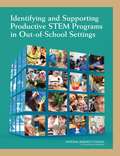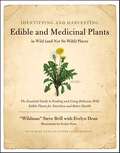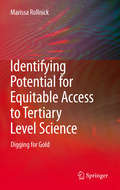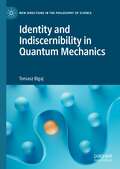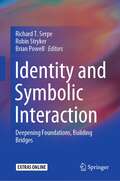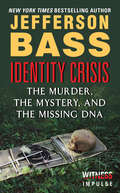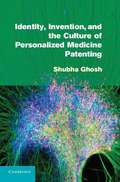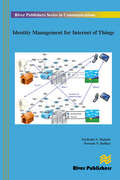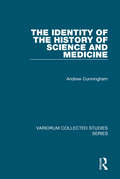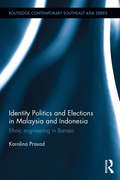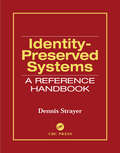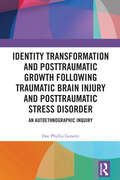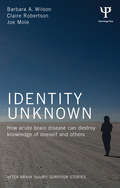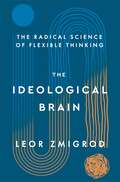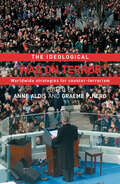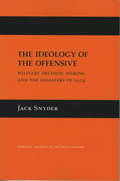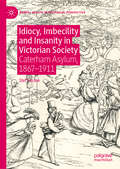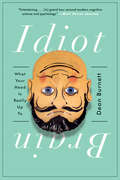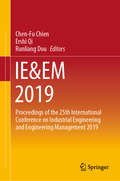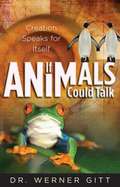- Table View
- List View
Identifying and Supporting Productive STEM Programs in Out-of-School Settings
by Committee on Successful Out-of-School STEM LearningMore and more young people are learning about science, technology, engineering, and mathematics (STEM) in a wide variety of afterschool, summer, and informal programs. At the same time, there has been increasing awareness of the value of such programs in sparking, sustaining, and extending interest in and understanding of STEM. To help policy makers, funders and education leaders in both school and out-of-school settings make informed decisions about how to best leverage the educational and learning resources in their community, this report identifies features of productive STEM programs in out-of-school settings. "Identifying and Supporting Productive STEM Programs in Out-of-School Settings" draws from a wide range of research traditions to illustrate that interest in STEM and deep STEM learning develop across time and settings. The report provides guidance on how to evaluate and sustain programs. This report is a resource for local, state, and federal policy makers seeking to broaden access to multiple, high-quality STEM learning opportunities in their community.
Identifying & Harvesting Edible and Medicinal Plants (And Not So Wild Places): The Essential Guide to Finding and Using Delicious Wild Edible Plants for Nutrition and Better Health
by Steve Brill Evelyn DeanIdentifying and Harvesting Edible and Medicinal Plants in Wild (and Not So Wild) Places shows readers how to find and prepare more than five hundred different plants for nutrition and better health. It includes information on common plants such as mullein (a tea made from the leaves and flowers suppresses a cough), stinging nettle (steam the leaves and you have a tasty dish rich in iron), cattail (cooked stalks taste similar to corn and are rich in protein), and wild apricots (an infusion made with the leaves is good for stomach aches and digestive disorders). More than 260 detailed line drawings help readers identify a wide range of plants -- many of which are suited for cooking by following the more than thirty recipes included in this book. There are literally hundreds of plants readily available underfoot waiting to be harvested and used either as food or as a potential therapeutic. This book is both a field guide to nature's bounty and a source of intriguing information about the plants that surround us.
Identifying Potential for Equitable Access to Tertiary Level Science
by Marissa RollnickHigher education internationally is in a state of transition and transformation, leading to an increase in the level of participation, and a consequent increase in number of non traditional and underprepared students. The appearance of these students provides a particular challenge in the sciences where adequate grounding is crucial. One response to this challenge has been the provision of access, foundation or "second chance programmes" which operate on different models internationally. In South Africa, where the push for equity is strong in the wake of the apartheid era, programmes have generally been established at all tertiary institutions with some of the most successful of these programmes based at universities characterised by a high research output. Consequently in the last decade there has been a great deal of research into the effectiveness of these programmes both at a micro and macro level. Similar research in other countries exists, but is patchy and often based on small groups of students. This book provides valuable information on what research has to say about disadvantaged and under prepared science students and how they learn - what works and what does not work. It provides an examination of issues related to the programmes, their structure, student selection and adjustment. Issues such the learning of these students, their communicative ability and laboratory work come under the spotlight. Although examining the issue internationally, the book draws heavily on lessons from South Africa where there has been considerably experience of such programmes.
Identifying the Complex Causes of Civil War: A Machine Learning Approach
by Atin Basuchoudhary James T. Bang John David Tinni SenThis book uses machine-learning to identify the causes of conflict from among the top predictors of conflict. This methodology elevates some complex causal pathways that cause civil conflict over others, thus teasing out the complex interrelationships between the most important variables that cause civil conflict. Success in this realm will lead to scientific theories of conflict that will be useful in preventing and ending civil conflict. After setting out a current review of the literature and a case for using machine learning to analyze and predict civil conflict, the authors lay out the data set, important variables, and investigative strategy of their methodology. The authors then investigate institutional causes, economic causes, and sociological causes for civil conflict, and how that feeds into their model. The methodology provides an identifiable pathway for specifying causal models. This book will be of interest to scholars in the areas of economics, political science, sociology, and artificial intelligence who want to learn more about leveraging machine learning technologies to solve problems and who are invested in preventing civil conflict.
Identifying Trees of the West: An All-Season Guide to Western North America
by Lois DeMarco Jay MengelA field guide to every common tree in Western North America, with hundreds of color photos. Learn how to recognize trees you see every day by their bark; branching patterns; fruits, flowers, or nuts; and overall appearance. Created for in-the-field or at-home use, this guide is an easy-to-use resource that covers every common tree in western North America—from the eastern base of the Rocky Mountains to the Pacific coast. Clearly written for both beginning and advanced botanists, it provides tips for identification throughout a tree&’s lifespan and in every season of the year.
Identity and Indiscernibility in Quantum Mechanics (New Directions in the Philosophy of Science)
by Tomasz BigajThis book analyzes metaphysical consequences of the quantum theory of many particles with respect to the fundamental notions of identity, individuality and discernibility. The main focus is on the proper interpretation of the quantum formalism in relation to the role of permutation invariance and the adequate representation of the properties of individual subsystems. Two main approaches to the issue of the individuation of quantum particles are distinguished and thoroughly discussed. These approaches differ radically with respect to their metaphysical consequences – while one of them implies the complete indiscernibility of quantum particles of the same kind, the other one restores the possibility of discerning individual particles by their properties. We connect the problem of quantum individuation and discernibility with an analysis of the concept of quantum entanglement, and we also discuss identity over time and in counterfactual scenarios.
Identity and Symbolic Interaction: Deepening Foundations, Building Bridges
by Richard T. Serpe Robin Stryker Brian PowellThis book examines identity theory’s centrality within social psychology and its foundations within structural symbolic interaction, highlighting its links not only to other prominent sociological subfields, but also to other theoretical perspectives within and beyond sociology. The book provides a synthetic overview outlining the intellectual lineage of identity theory within structural symbolic interactionism, and how the “Indiana School” of identity theory and research, associated especially with Sheldon Stryker, relates to other symbolic interactionist traditions within sociology. It also analyses the latest developments in response to the push to integrate identity theory, which initially focused on role identities, with the study of personal, group and social identities. Further, it discusses the relationship between identity theory and affect control theory, providing a sense of the many substantive topics within sociology beyond social psychology for which the study of identity has important, sometimes underappreciated implications. The book concludes with a chapter summarizing the interrelated lessons learned while also reflecting on remaining key questions and challenges for the future development of identity theory.
Identity Crisis
by Jefferson BassRenowned forensic anthropologist Bill Bass--founder of the Body Farm--tackles one of his most baffling cases ever in this real-life spellbinder In 1978, 56-year-old Leoma Patterson left a bar in Clinton, Tennessee, and was never seen again. Six months later, a female skeleton was found on a wooded lakeshore in a neighboring county. The bones were consistent with those of the missing woman, and one of Patterson's daughters recognized a ring found at the death scene as her mother's. The bones were buried, and six years later, a relative of Patterson's--one of the men she was last seen alive with--confessed to killing her. Case closed.But the tentative identification--made years before DNA testing was available to confirm it--failed to convince some of Patterson's relatives. And so it was that in 2005 Dr. Bass found himself winding around hairpin curves to the mountainside grave, where he would unearth the disputed remains and collect DNA samples. The forensic twists and turns that followed would test the limits of DNA technology ... and of Dr. Bass's half-century of forensic knowledge.
Identity, Invention, and the Culture of Personalized Medicine Patenting
by Shubha GhoshWhat are the normative implications of patenting in the area of personalized medicine? As patents on genes and medical diagnoses have increased over the past decade, this question lies at the intersection of intellectual property theory, identity politics, biomedical ethics and constitutional law. These patents are part of the personalized medicine industry, which develops medical treatments tailored to individuals based on race and other characteristics. This book provides an overview of developments in personalized medicine patenting and suggests policies to best regulate such patents.
Identity Management for Internet of Things (River Publishers Series In Communications Ser.)
by Parikshit N. Mahalle Poonam N. RailkarThe Internet of Things is a wide-reaching network of devices, and these devices can intercommunicate and collaborate with each other to produce variety of services at any time, any place, and in any way. Maintaining access control, authentication and managing the identity of devices while they interact with other devices, services and people is an important challenge for identity management. The identity management presents significant challenges in the current Internet communication. These challenges are exacerbated in the internet of things by the unbound number of devices and expected limitations in constrained resources. Current identity management solutions are mainly concerned with identities that are used by end users, and services to identify themselves in the networked world. However, these identity management solutions are designed by considering that significant resources are available and applicability of these identity management solutions to the resource constrained internet of things needs a thorough analysis. Technical topics discussed in the book include:• Internet of Things;• Identity Management;• Identity models in Internet of Things;• Identity management and trust in the Internet of Things context;• Authentication and access control;Identitymanagement for Internet of Things contributes to the area of identity management for ubiquitous devices in the Internet of Things. It initially presents the motivational factors together with the identity management problems in the context of Internet of Things and proposes an identity management framework. Following this, it refers to the major challenges for Identitymanagement and presents different identity management models. This book also presents relationship between identity and trust, different approaches for trust management, authentication and access control.
The Identity of the History of Science and Medicine (Variorum Collected Studies)
by Andrew CunninghamIn these essays, Andrew Cunningham is concerned with issues of identity - what was the identity of topics, disciplines, arguments, diseases in the past, and whether they are identical with (more usually, how they are not identical with) topics, disciplines, arguments or diseases in the present. Historians usually tend to assume such continuous identities of present attitudes and activities with past ones, and rarely question them; the contention here is that this gives us a false image of the very things in the past that we went to look for.
Identity Politics and Elections in Malaysia and Indonesia: Ethnic Engineering in Borneo (Routledge Contemporary Southeast Asia Series)
by Karolina PrasadIn recent social research, ethnicity has mostly been used as an explanatory variable. It was only after it was agreed that ethnicity, in itself, is subject to change, were the questions of how and why it changes, possible to answer. This multiplicity of ethnic identities requires that we think of each society as one with multiple ethnic dimensions, of which any can become activated in the process of political competition - and sometimes several of them within a short period of time. Focusing on Malaysia and Indonesia, this book traces the variations of ethnic identity by looking at electoral strategies in two sub-national units. It shows that ethnic identities are subject to change - induced by calculated moves by political entrepreneurs who use identities as tools to maximize their chances of winning elections or expanding support base - and highlights how political institutions play an enormous role in shaping the modes and dynamics of these ethno-political manipulations. The book suggests that in societies where ethnic identities are activated in politics, instead of analysing politics with ethnic distribution as an independent variable, ethnic distribution can be taken as the dependent variable, with political institutions being the explanatory one. It examines the problems of voters’ behaviour, and parties’ and candidates’ strategy in a polity that is, to a significant extent, driven by ethnic relations. Pushing the boundaries of qualitative research on Southeast Asian politics by placing formal institutions at the centre of its analysis, this book will be of interest to students and scholars of Southeast Asian Politics, Race and Ethnic Studies, and International Relations.
Identity-Preserved Systems: A Reference Handbook
by Dennis StrayerIdentity-Preserved Systems: A Reference Handbook provides background for the development of processes or systems of maintaining the segregation of and documenting the identity of a product. Growers and other parties that handle, transport, condition, or process the identity-preserved (IP) product must follow strict growing and handling practices, i
Identity Transformation and Posttraumatic Growth Following Traumatic Brain Injury and Posttraumatic Stress Disorder: An Autoethnographic Inquiry
by Dee Phyllis GenettiIdentity Transformation and Posttraumatic Growth Following Traumatic Brain Injury and Posttraumatic Stress Disorder provides an autoethnographic qualitative study that portrays the author’s recovery from a devastating life-changing event – a car crash resulting in the hybrid diagnosis of traumatic brain injury (TBI) and posttraumatic stress disorder (PTSD), leading to posttraumatic growth ( PTG) and identity transformation over a ten-year recovery period. In so doing, the text offers a comprehensive literature review on TBI, PTSD, PTG and disability culture. Throughout, the author explores whether growth (PTG) and distress (PTSD) and whether TBI and PTSD can co-exist. Having lost her ability to read and write, the author had to learn how to learn, to heal and to have faith again. As a licensed trauma therapist and researcher, she collected self-observational data by writing her actual behaviors, thoughts and emotions in real time, both in a field and a process journal, even before she could write in full sentences. The many symptoms and co-morbidities of TBI and PTSD and the tenets of PTG are portrayed as they evolved in recovery showing the behaviors and characteristics of each. The text refers to actual journal entries, medical records and clinical notes from rehabilitation specialists, alternating between her clinical analysis and interpretation. The findings show that tragedy and suffering can lead to growth and positive change (PTG) after TBI, even though the precipitating trauma and psychological distress (PTSD) may persist for years. Changes are seen in self-perception, interpersonal relationships and philosophies of life. This chronicled account of the author’s emergent recovery from patient to doctor is intended to benefit neuro-rehabilitation service providers (neuropsychologists, primary care physicians, speech-language pathologists) and also mental health clinicians who can see the evolution of PTG for what is now the new next step for many in PTSD recovery.
Identity Unknown: How acute brain disease can destroy knowledge of oneself and others (After Brain Injury: Survivor Stories)
by Barbara A. Wilson Claire Robertson Joe MoleImagine being unable to recognise your spouse, your children, or even yourself when you look in the mirror, despite having good eyesight and being able to read well and name objects. This is a condition which, in rare cases, some brain injury survivors experience every day. Identity Unknown gives an exceptional, poignant and in-depth understanding of what it is like to live with the severe after-effects of brain damage caused by a viral infection of the brain. It tells the story of Claire, a nurse, wife, and mother of four, who having survived encephalitis, was left with an inability to recognise faces – a condition also known as prosopagnosia together with a loss of knowledge of people and more general loss of semantic memory Part One describes our current knowledge of encephalitis, of perception and memory, and the theoretical aspects of prosopagnosia and semantic memory. Part Two, told in Claire’s own words, is an account of her life before her illness, her memories of the early days in hospital, an account of the treatment she received at the Oliver Zangwill Centre, and her description of the long-term consequences of encephalitis. Claire’s profound insights, clear writing style, and powerful portrayal of her feelings provide us with a moving insider’s view of her condition. These chapters also contain additional commentary from Barbara Wilson, providing further detail about the condition, treatment possibilities, potential outcomes, and follow-up options. Identity Unknown provides a unique personal insight into a condition which many of us have, for too long, known too little about. It will be of great interest to a broad audience including professionals working in rehabilitation settings, and all those who have sustained a brain injury, their families and carers.
The Ideological Brain: The Radical Science of Flexible Thinking
by Leor ZmigrodNamed a best book of the year by The Guardian and The TelegraphWhy do some people become radicalized? How do ideologies shape the human brain? And how can we unchain our minds from toxic dogmas?In The Ideological Brain, Leor Zmigrod reveals the deep connection between political beliefs and the biology of the brain. Drawing on her own pioneering research, she uncovers the complex interplay between biology and environment that predisposes some individuals to rigid ways of thinking, and explains how ideologies take hold of our brains, fundamentally changing the way we think, act and interact with others. She shows how ideologues of all types struggle to change their thought patterns when faced with new information, culminating in the radical message that our politics are not superficial but are woven into the fabric of our minds.This authoritative, accessible and playful blend of psychology, politics and philosophy explores the cutting-edge of the emerging field of political neuroscience. Zmigrod examines its historical roots before she looks to the future, considering the broader social and political implications of her groundbreaking research. Guiding readers through her experiments, she eventually describes what a free, authentic, and tolerant brain looks like, and explains how anyone can keep their mind open and flexible in the face of extremist ideologies.
Ideological Seduction and Intellectuals in Putin's Russia
by Dmitry ShlapentokhThis book examines the interplay between key rulers and intellectuals in creating and sustaining popular discourses that often help keep rulers in power. By focusing in particular on the relationship between Putin and Dugin during the early Putin regime, the author zooms in on the questionable honesty in Putin's interest in Dugin's philosophy, and the instrumentality of that philosophy for strategic regime building. Arguing that ideology is largely supported by political philosophies that gain popular traction, the book questions the extent to which rulers are likely to stay faithful to their stated ideologies. Providing on-the-ground insight into Putin's rule, this book appeals to researchers and policymakers studying Post-Soviet Politics.
The Ideological War on Terror: Worldwide Strategies For Counter-Terrorism (Political Violence)
by Graeme P. Herd Anne AldisThis edited book addresses the appropriateness of US and other counter-terrorist (CT) strategies in Europe and Eurasia, the Middle East, the Asia Pacific region and in Latin America, with a view to improving their effectiveness. The book has three main objectives: to re-examine terrorists' strategic goals and sources of legitimacy and the nature of their ideological support to analyze current US and regional CT strategies and assess their success in de-legitimizing terrorists and undermining their support to provide a strategic synthesis and policy recommendations in light of the research findings. This book will be of interest to students of political violence and terrorism, security studies and international relations in general.
The Ideology of the Offensive
by Jack SnyderJack Snyders analysis of the attitudes of military planners in the years prior to the Great War offers new insight into the tragic miscalculations of that era and into their possible parallels in present-day war planning. By 1914, the European military powers had adopted offensive military strategies even though there was considerable evidence to support the notion that much greater advantage lay with defensive strategies. The author argues that organizational biases inherent in military strategists attitudes make war more likely by encouraging offensive postures even when the motive is self-defense. Drawing on new historical evidence of the specific circumstances surrounding French, German, and Russian strategic policy, Snyder demonstrates that it is not only rational analysis that determines strategic doctrine, but also the attitudes of military planners. Snyder argues that the use of rational calculation often falls victim to the pursuit of organizational interests such as autonomy, prestige, growth, and wealth. Furthermore, efforts to justify the preferred policy bring biases into strategists decisions biases reflecting the influences of parochial interests and preconceptions, and those resulting from attempts to simplify unduly their analytical tasks. The frightening lesson here is that doctrines can be destabilizing even when weapons are not, because doctrine may be more responsive to the organizational needs of the military than to the implications of the prevailing weapons technology. By examining the historical failure of offensive doctrine, Jack Snyder makes a valuable contribution to the literature on the causes of war.
Idiocy, Imbecility and Insanity in Victorian Society: Caterham Asylum, 1867–1911 (Mental Health in Historical Perspective)
by Stef EastoeThis book explores the understudied history of the so-called ‘incurables’ in the Victorian period, the people identified as idiots, imbeciles and the weak-minded, as opposed to those thought to have curable conditions. It focuses on Caterham, England’s first state imbecile asylum, and analyses its founding, purpose, character, and most importantly, its residents, innovatively recreating the biographies of these people. Created to relieve pressure on London’s overcrowded workhouses, Caterham opened in September 1870. It was originally intended as a long-stay institution for the chronic and incurable insane paupers of the metropolis, more commonly referred to as idiots and imbeciles. This purpose instantly differentiates Caterham from the more familiar, and more researched, lunatic asylums, which were predicated on the notion of cure and restoration of the senses. Indeed Caterham, built following the welfare and sanitary reforms of the late 1860s, was an important feature of the Victorian institutional landscape, and it represented a shift in social, medical and political responsibility towards the care and management of idiot and imbecile paupers.
Idiot Brain: What Your Head Is Really Up To
by Dean BurnettA neuroscientist's delightful tour of our mysterious, mischievous, entirely fallible gray matter. It's happened to all of us at some point. You walk into the kitchen, or flip open your laptop, or stride confidently up to a lectern, filled with purpose—and suddenly haven't the foggiest idea what you’re doing. Welcome to your idiot brain. Yes, it is an absolute marvel in some respects—the seat of our consciousness, the pinnacle (so far) of evolutionary progress, and the engine of all human experience—but your brain is also messy, fallible, and about 50,000 years out-of-date. We cling to superstitions, remember faces but not names, miss things sitting right in front of us, and lie awake at night while our brains replay our greatest fears on an endless loop. Yet all of this, believe it or not, is the sign of a well-meaning brain doing its best to keep you alive and healthy. In Idiot Brain, neuroscientist Dean Burnett celebrates blind spots, blackouts, insomnia, and all the other downright laughable things our minds do to us, while also exposing the many mistakes we've made in our quest to understand how our brains actually work. Expertly researched and entertainingly written, this book is for everyone who has wondered why their brain appears to be sabotaging their life, and what on earth it is really up to.
The Idiot Brain: A Neuroscientist Explains What Your Head Is Really Up To
by Dean BurnettThe brain may be the seat of consciousness and the engine of all human experience, but it’s also messy, fallible and disorganized. It’s undeniably impressive, but it’s far from perfect, and these imperfections influence everything that humans say, do and experience. In The Idiot Brain, Dean Burnett celebrates the downright laughable things our minds do to us, as well as exposing the fact that people are often way off in their thinking about how the brain works. For example, did you know thatyour memory is egotistical?stress can actually increase your performance at a task?conspiracy theories and superstitions stem from your brain’s insistence that the world isn’t random?the brain’s limitations mean you really can miss something that’s right under your nose?the way the brain’s processing works means that time really does fly if you’re having fun?alcohol can sometimes improve your memory?Dean Burnett’s unpredictable and entertaining first book explores the unexpected side of everyday life, highlighting where conventional thinking is wrong and how our brains trip us up at every turn. This is lucid, funny and smart: in short, the best kind of popular science.
IE&EM 2019: Proceedings of the 25th International Conference on Industrial Engineering and Engineering Management 2019
by Chen-Fu Chien Ershi Qi Runliang DouThis book records the new research findings and development in the field of industrial engineering and engineering management, and it will serve as the guidebook for the potential development in future. It gathers the accepted papers from the 25th International conference on Industrial Engineering and Engineering Management held at Anhui University of Technology in Maanshan during August 24-25, 2019. The aim of this conference was to provide a high-level international forum for experts, scholars and entrepreneurs at home and abroad to present the recent advances, new techniques and application, to promote discussion and interaction among academics, researchers and professionals to promote the developments and applications of the related theories and technologies in universities and enterprises, and to establish business or research relations to find global partners for future collaboration in the field of Industrial Engineering. It addresses diverse themes in smart manufacturing, artificial intelligence, ergonomics, simulation and modeling, quality and reliability, logistics engineering, data mining and other related fields. This timely book summarizes and promotes the latest achievements in the field of industrial engineering and related fields over the past year, proposing prospects and vision for the further development.
If Animals Could Talk
by Dr Werner GittIf animals could tell us about themselves, using our scientific knowledge, if they could tell us about the way they live, the special way they are made and many details about their individual design - what they would say would be unique praise to the Creator. Did you know that while in flight, the sparrow's heart can beat up to 760 times per minute? Or that a baby blue whale grows at a rate of 7.28 pounds an hour while it's nursing, a grand total of 17 tons by the end of the nursing stage? How about that glow worms have a light output efficiency of 100% as compared to only 4% for our incandescent bulbs? Dr. Werner Gitt, one of the foremost creationist speakers in the world, uses his scientific expertise in this book to show the unique design features of some of God's most captivating creations. All people, young and old, layperson or expert, will be able to understand and enjoy this straightforward book. Told from the perspective of the animals being described, If Animals Could Talk clearly shows the impossibility of life without design. Dr. Gitt uses simple language to provoke a sense of wonder and awe at the marvelous design of the Creator.
